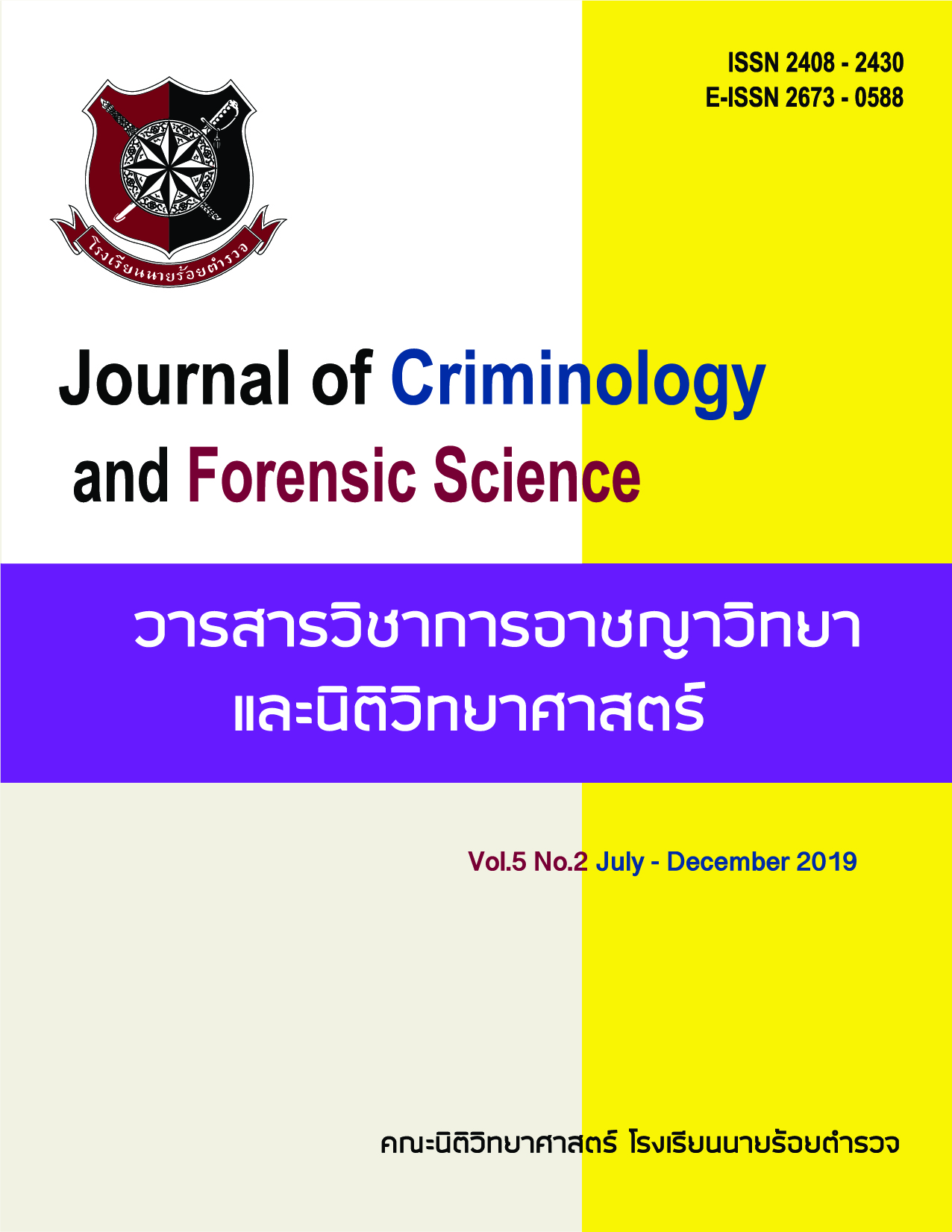การเปิดรับข่าวอาชญากรรมของเด็กและเยาวชน ศึกษาเฉพาะกรณี สถานพินิจและคุ้มครองเด็กและเยาวชนจังหวัดอุบลราชธานี
Main Article Content
บทคัดย่อ
การวิจัยครั้งนี้มีวัตถุประสงค์เพื่อศึกษาการเปิดรับข่าวอาชญากรรมของเด็กและเยาวชนในสถานพินิจและคุ้มครองเด็กและเยาวชนจังหวัดอุบลราชธานี เพื่อศึกษาความคิดเห็นเกี่ยวกับอิทธิพลของข่าวอาชญากรรมของเด็กและเยาวชนในสถานพินิจและคุ้มครองเด็กและเยาวชนจังหวัดอุบลราชธานี และเพื่อศึกษาแนวทางการป้องกันผลกระทบจากข่าวอาชญากรรมแก่เด็กและเยาวชน เป็นการวิจัยแบบผสมผสานระหว่างการวิจัยเชิงปริมาณและการวิจัยเชิงคุณภาพ ประชากรคือ เด็กและเยาวชนในสถานพินิจและคุ้มครองเด็กและเยาวชนจังหวัดอุบลราชธานี จำนวนทั้งหมด 736 คน การวิจัยเชิงปริมาณกำหนดกลุ่มตัวอย่างจำนวน 246 คน เก็บรวบรวมข้อมูลด้วยวิธีการสุ่มตัวอย่างแบบโควตาตามแต่ละกลุ่มคดีความผิด วิเคราะห์ข้อมูลโดยใช้สถิติพรรณนาและสถิติแบบพารามิเตอร์ ส่วนการวิจัยเชิงคุณภาพใช้แบบสัมภาษณ์เก็บข้อมูลเยาวชนในความผิดคดีต่าง ๆ จำนวน 11 คน ด้วยวิธีการเลือกแบบเจาะจง
ผลการวิจัยพบว่า 1) การเปิดรับข่าวอาชญากรรมของเด็กและเยาวชนส่วนใหญ่จากเว็บไซต์ซึ่งสนใจข่าวเกี่ยวกับยาเสพติดมากที่สุดโดยติดตามข่าวการจับกุม ดำเนินคดีและบทลงโทษ ปัจจัยที่ทำให้เยาวชนรับชมข่าวอาชญากรรม คือมีผู้ปกครองคอยตักเตือนและให้บทเรียนมากที่สุด 2) ความคิดเห็นเกี่ยวกับอิทธิพลของข่าวอาชญากรรม พบว่า เยาวชนที่อายุต่ำกว่า 10 ปี คิดว่าข่าวอาชญากรรมทำให้เกิดเรียนรู้เทคนิควิธีของการก่ออาชญากรรมรูปแบบต่าง ๆ มากกว่าเยาวชนอายุตั้งแต่ 10 ปีขึ้นไป
ส่วนเยาวชนที่กระทำผิดคดีพกอาวุธปืนโดยไม่ได้รับอนุญาต และคดีลักทรัพย์ คิดว่าข่าวอาชญากรรมมีอิทธิพลต่อการเรียนรู้และเลียนแบบการกระทำผิด และ 3) แนวทางการป้องกันผลกระทบจากข่าวอาชญากรรมสำหรับเด็กและเยาวชน คือ ครอบครัวควรตักเตือนให้คำแนะนำในเชิงบวก องค์กรสื่อมวลชนควรเน้นการนำเสนอบทลงโทษผู้กระทำผิด และควรเน้นข่าวการนำเสนอข่าวการป้องกันตัวจากภัยอาชญากรรม
Article Details
เนื้อหาและข้อมูลในบทความที่ลงตีพิมพ์ใน วารสารวิชาการอาชญาวิทยาและนิติวิทยาศาสตร์ โรงเรียนนายร้อยตำรวจ ถิอว่าเป็นข้อคิดเห็นและความรั้บผิดชอบของผู้เขียนบทความโดยตรงซึ่งกองบรรณาธิการวารสาร ไม่จำเป็นต้องเห็นด้วยหรือรับผิดชอบใดๆ
บทความ ข้อมูล เนื้อหา รูปภาพ ฯลฯ ที่ได้รับการตีพิมพ์ใน วารสารวิชาการอาชญาวิทยาและนิติวิทยาศาสตร์ ถือว่าเป็นลิขสิทธิ์ของวารสาร วารสารวิชาการอาชญาวิทยาและนิติวิทยาศาสตร์ หากบุคคลหรือหน่วยงานใดต้องการนำทั้งหมดหรือส่วนหนึ่งส่วนใดไปเผยแพร่ต่อหรือเพื่อกระทำการใดๆ จะต้องได้รับอนุญาตเป็นลายลักษณ์อักษรจาก วารสารวิชาการอาชญาวิทยาและนิติวิทยาศาสตร์ ก่อนเท่านั้น
เอกสารอ้างอิง
2. Atkin, Charles K. (1973). Anticipated communication and mass media information seeking public opinion quarterly. New york: Free Press.
3. Bloom, B.S., Engelhart, M.D., Furst, E.J., Hill, W.H., & Krathwohl, D.R. (1956). Taxonomy of Educational Objectives, Handbook I: The Cognitive Domain. New York: David McKay Co Inc.
4. Boeree, C. George. (2009). Personality Theory: A Biosocial Approach. Retrieved January 12, 2018. Form https://webspace.ship.edu/cgboer/genpsyneurosis.html
5. Chutinant, A. (2014). Criminology and Penology. (2nd ed). Bangkok: Winyuchon. (In Thai).
6. Chuanpipatpong, W. (2012). A comparative study of social responsibility in the presentation of crime news between newspapers and online newspapers. Retrieved October 24, 2017. From www.spu.ac.th/commarts/files/2013/09/. (In Thai).
7. Chaiyachai, R. (2010). Social learning theory and stone-throwing behavior: the measure of crime prevention, crime control and crime solving. Master of Sociology Thesis Criminology and Justice. Chulalongkorn University, Bangkok. (In Thai).
8. Department of Juvenile Observation and Protection. (2015). Annual Statistics Report 2014. Bangkok: Information Technology Center, Department of Juvenile Observation and Protection. (In Thai).
9. Eron, L. D. (1987). The development of aggressive behavior from the perspective of a developing behaviorism. American Psychologist, 42, 435-442.
10. Hirschi, T. (1969). Causes of Delinquency. Berkeley, CA: University of California Press.
11. Hunt, T. & Ruben, B.D. (1993). Mass Communication: Producer and Consumers.
New York, NY: Harper College Publishers.
12. Intaraprasert, S. (2012). Research on the influence of media that is related to behavior Violence of children and youth in Bangkok. Bangkok: Suan Dusit Rajabhat University. (In Thai).
13. Kaewthep, K. (2009). Analysis of media, concepts and techniques. (4th ed). Bangkok:
Faculty of Communication Arts Chulalongkorn University. (In Thai)
14. Kong, L.L., Maria, C.A., & Samsilah, R. (2010). Understanding Media Violence and Development of Aggressive Behavior of School Children. Procardia Social and Behavioral Sciences. 7(C), 522-527.
15. Khantee, P., Phutrakul, K. & Trimek, C. (2015). Criminology theory: principles Research and Applied Policy. Bangkok: S. Charoen Printing. (In Thai).
16. Lipschultz, Jeremy. (2017). Crime News on TV. Retrieved September 21, 2018, From https://criminology.oxfordre.com/view/10.1093/acrefore/9780190264079.001.0001/acrefore-9780190264079-e-57.
17. Louden, L., & Bitta, A. (1993). Consumer Behavior (4th ed.). Singapore: McGraw Hill Book.
18. McCombs, M. E. & Becker, L.B. (1979). Using mass communication theory. New York:
Prentice Hall.
19. Morgan, M. (2009). Cultivation analysis and media effects. Mahwah, NJ: Lawrence Erlbaum Associates.
20. National Statistical Office. (2017). Survey of the use of information and communication technology in the household. Retrieved September 25, 2017. From https://service.
nso.go.th/nso/web/statseries/statseries 22.ht. (In Thai).
21. National Statistical Office. (2017). Latent population survey in Thailand, 2017. Retrieved August 6, 2018. From https://www.nso.go.th/sites/2014/Pages/News/2561/N21-09-61-2.aspx. (In Thai).
22. Observation and Protection Center for Juvenile in Ubon Ratchathani Province. (2017).
Child and youth statistics that were Prosecuted by the Observation and
Protection Center of Ubon Ratchathani. Ubon Ratchathani. (In Thai).
23. Offenhauer, P., & Buchalter, A. (2011).Teen Dating Violence: A Literature Review and Annotated Bibliography. Library of Congress – Federal Research Division. Washington, D.C.: Department of Justice.
24. Raksaewkaew, K. (2017). The Influence of Programs in New Media on the Perspective on the World of Children and Youth. Veridian E-Journal, Silpakorn University.
10 (3), 152 - 169. (In Thai).
25. Roengsak, P. (2011). Crime news as a narrative form in the press. Executive journal.
31(2), 205-211. (In Thai).
26. Siegel, Larry J. (2011). Criminology. Singapore: Thomson, Wadsworth.
27. Siriyuwasak, U. (2007). Basic mass communication: media, culture and society.
(2nd ed) (revised version). Bangkok: Chulalongkorn University Press. (In Thai)
28. Sri Sa-at, S. (2017). Principles of preliminary research. (10 th ed). Bangkok: Suviriyasan.
(In Thai).
29. Srikumnid, S. (2009). The role of "crime news" and guiding people in society.
Retrieved October 24, 2017. From https://www.tja.or.th/index.php?option=com_content
&view = article & id. (In Thai).
30. Sutheesorn, S. (2004). Criminology. (2nd ed). Bangkok: Thammasat University. (In Thai)
31. Surette, R. (2015). Crime Media. Culture: An International Journal.12(1), 37-64.
32. Thairath Online. (2014). Collecting single invasions, hijacking money, Lotus, Chonburi Unemployed claims – gambling. Re. Retrieved September 23, 2018. From https://www.thairath.co.th/content/461955. (In Thai).
33. Thaniyaphon, P. (2011). Criminology and Penology. (8th ed). Bangkok: Ramkhamhaeng
University. (In Thai).
34. Ung Phra, N. T. (2012). Social psychology. Bangkok: Thammasat University. (In Thai).
35. Witthayarat, S. (2006). Production of print media. (5th ed). Cage Thep: Suan
Sunandha Book Center. (In Thai).
36. Yando, R., Seitz, V. & Zigler, E. (1978). Imitation: A Development Perspective. New Jersey, NJ: Lawrence Erbaum Associate.


